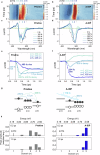Kinetically-controlled intermediate-direct-pinning for homogeneous energy landscapes in quasi-two-dimensional perovskites for efficient and narrow blue emission
- PMID: 41168213
- PMCID: PMC12575853
- DOI: 10.1038/s41467-025-62863-y
Kinetically-controlled intermediate-direct-pinning for homogeneous energy landscapes in quasi-two-dimensional perovskites for efficient and narrow blue emission
Abstract
Quasi-two-dimensional perovskite structures hold great potential as active layers in blue perovskite light-emitting diodes. However, they face challenges of limited emission efficiency and broadened spectra due to phase inhomogeneity. Here, we report an intermediate-direct-pinning method to develop a uniform-phase quasi-two-dimensional structure with a homogeneous energy landscape. By forming a strong cation-π interaction complex, we stabilize a metastable intermediate phase with retarded crystallization toward low-n phases (n ≤ 3), followed by a direct pinning process favouring crystallization of medium-n phases (n = 4 and 5) without further broadening. Additionally, introducing a surface-anchoring ligand during the pinning process effectively suppresses non-radiative recombination. The resultant structure shows efficient sky-blue emission and narrow linewidth (108 meV). Devices fabricated with this structure reach a maximum external quantum efficiency of 22.5% at 489 nm, which is scalable to large-area (pixel size: 900 mm2) and passive matrix devices (30 × 10 arrays, active area = 200 μm × 600 μm). These findings highlight the potential of perovskite light-emitting diodes for full-colour displays.
© 2025. The Author(s).
Conflict of interest statement
Competing interests: The authors declare no competing interests.
Figures




References
-
- Cho, H. et al. Overcoming the electroluminescence efficiency limitations of perovskite light-emitting diodes. Science. 350, 1222–1225 (2015). - PubMed
-
- Han, T.-H. et al. A roadmap for the commercialization of perovskite light emitters. Nat. Rev. Mater.7, 757–777 (2022).
-
- Ma, D. et al. Distribution control enables efficient, reduced-dimensional perovskite LEDs. Nature599, 594–598 (2021). - PubMed
-
- Kim, Y.-H. et al. Comprehensive defect suppression in perovskite nanocrystals for high-efficiency light-emitting diodes. Nat. Photon.15, 148–155 (2021).
-
- Kim, J. S. et al. Ultra-bright, efficient and stable perovskite light-emitting diodes. Nature611, 688–694 (2022). - PubMed
Grants and funding
LinkOut - more resources
Full Text Sources
Research Materials
Miscellaneous

